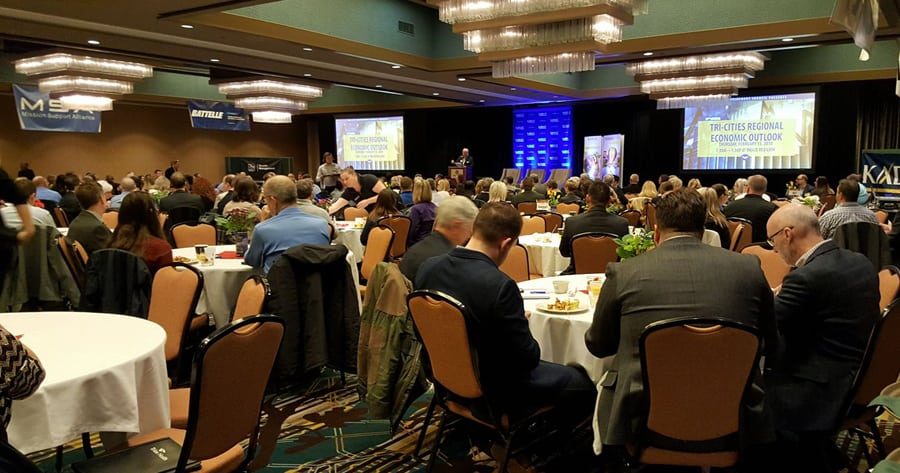
Home » Industry experts give robust economic forecast for Tri-Cities
Industry experts give robust economic forecast for Tri-Cities

March 14, 2018
A robust retail, housing and jobs market has industry experts singing the region’s economic praises.
Several community leaders provided industry highlights during Tri-City Development Council’s annual economic outlook conference Feb. 15 at the Pasco Red Lion.
Barbara Johnson, manager of Columbia Center mall in Kennewick, called the Tri-City’s retail sector well positioned, serving as a regional shopping hub for the area.
“Despite what you hear in other areas about retail, the Tri-City area is still doing very well in terms of its retail industry,” she said.
Johnson pointed to last year’s Tri-City sales tax distributions totaling more than $42 million, a three percent increase over 2016.
Statewide, sales tax distributions increased 7.4 percent. In Benton County, they rose 10.8 percent and in Franklin County they went up 4.8 percent.
“It continues to be a state that obviously is doing well in the retail sector and people are continuing to buy in our areas,” she said.
She said recent — and past — headlines about online shopping putting malls out of business aren’t true.
She pointed to a Time magazine story about the demise of malls in 1998 under the headline, “Kiss your mall goodbye”
“We’re still here. Like every industry, we go through restructuring,” she said.
Johnson said Columbia Center is 97.4 percent leased. “There’s not a lot of vacancy,” she said.
Nationwide, brick-and-mortar stores represent 90 percent of the total retail sales pie of $4.5 trillion, she said.
“Not everybody wants to buy online,” she said. “Most people want to lay on their mattress before they purchase it.”
She said 72 percent of Generation Z members visit the mall at least once a month. This is the group born between the mid-1990s to mid-2000s that follows Generation X. “They still like to see their friends and share the experience of the mall, or anywhere you can find great entertainment and dining,” she said.
Johnson said she sees a “lot of pent up demand for retailers to come into this market” who are waiting for the “right opportunity or right piece of property,” she said.
That said, she cautioned shoppers to continue to spend their money in local shops.
“We have to support our retail in the Tri-Cities,” she said.
Housing market
The region recorded a four percent year-over-year increase in the number of single-family residential permits filed in 2017, with 1,446 tallied in Benton and Franklin counties.
“We’re still very bullish,” said Jeff Losey, president of the Home Builders Association of Tri-Cities.
He said to expect more of the same in 2018.
In 2017, a total of 4,182 homes were sold in Kennewick (1,586), Pasco (1,198), Richland (1,069) and West Richland (329). Of those homes sold, 23 percent were new construction and 77 percent were re-sales.
Historically, the area typically has 1,250 homes on the market, said Vicki Monteagudo, owner and broker of Century 21 Tri-Cities and principal partner of NAI Tri-Cities Commercial. On the day of the TRIDEC meeting, there were about 450.
“Houses at certain price points are lasting days, if not hours,” she said.
She said inventories are low and demand is extremely high.
Home prices will continue to rise in 2018 with increasing labor, material and land costs, Monteagudo said.
“I hope that echoes really loud. … It’s hard for builders to get ahead. Window (costs) are up 5 percent to 8 percent. Cabinet (costs) always go up. The builders can’t get ahead of the pricing,” she said, saying some consumers may erroneously think builders are making money hand-over-fist. But, she said, profit margins are at the lowest point since 2015.
She said agents were selling lots for $40,000 in 2014 and now they’re going for $65,000. Builders typically allocate 20 percent of the overall price of the home for land acquisition, she said.
The Tri-City’s median home price in 2017 grew to $252,800 from $229,900 in 2016.
The Federal Housing Finance Agency’s loan limits for mortgages in Benton and Franklin counties have increased from $417,000 to $453,100 and interest rates are on rise — from 3.25 percent in 2016 to 4.25 percent in 2018 — with the historical average at 8 percent.
Jobs
The bi-county area is expected to have a good run in employment with the labor force rebound shaping supply and demand, reported Asja Sulic, a state regional labor economist.
She said industries to watch are manufacturing, health care, education, transportation and warehousing, and leisure and hospitality.
The Kennewick-Richland labor force totaled 135,621 in December 2017, up 1.7 percent over the previous year.
Washington added an estimated 91,900 new jobs from January 2017 through January 2018, not seasonally adjusted, according to recently released state data. The private sector grew by 3.1 percent, or 82,600 jobs, and the public sector increased by 1.6 percent, adding 9,300 jobs.
The three industry sectors with the largest employment gains year-over-year, not seasonally adjusted, were: professional and business services with 15,700 new jobs; construction with 14,100 new jobs; and education and health services with 14,100 new jobs.
Washington’s economy added 6,800 jobs in January and the state’s seasonally adjusted monthly unemployment rate was 4.7 percent, according to the state Employment Security Department.
Benton County’s unemployment rate was 6.8 percent and Franklin County’s is 8.8 percent in January, not seasonally adjusted.
The national unemployment rate was 4.1 percent in January.
The state’s labor force totaled 3,757,900 — an increase of 3,000 people from the previous month.
The labor force is the total number of people, both employed and unemployed, over the age of 16.
The most recent statewide report, with data from January, shows the greatest private job growth occurred in construction, up 3,100; professional and business services, up 2,000; and retail trade, up 1,800.
Other sectors adding jobs were transportation, warehousing and utilities, up 1,100; manufacturing, up 700; and wholesale trade, up 600.
Local News
KEYWORDS march 2018




